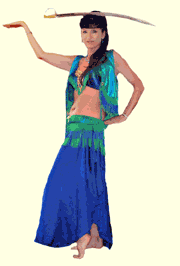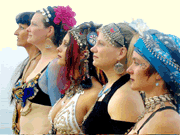Shake Your Money-maker for Fitness and Fun
On the job with Ishtari, belly dance instructor
by Maria Bellos
Baubles, beads and shiny coins sparkle and catch the light as hips gyrate and shimmy, sending metal flying and fabric flowing. Six women are dancing to discover their inner grace and sexuality in an exotic fertility ritual performed by priestesses for thousands of years. The women are learning what tribes in the East have passed to their daughters through the ages: the sensuous, rhythmic, alluring art of belly dance.
They range from young to middle-aged, from petite to average to ample, and their reasons are as different as they are: joint health, weight loss, fascination with Eastern cultures. Only this belly dance class, meeting weekly in instructor Ishtari’s home in Chesapeake Beach, brings them together.
“I like to show others how they can also improve their self-esteem and do a lot for their health with a workout that is so much more fun than work,” says Ishtari, aka Carmen Nolte.
Joining the Harem
Baubles, beginning with an audible adornment for her waist, are the first order of business for a newcomer. A black scarf festooned with fake silver coins and beads tinkles around my waist, emphasizing ample hips. But why worry? Everyone else has some bling attached to her money-maker, and they are ready to shake it.
We flex so many muscles and tendons warming up that even this kickboxing veteran aches by the time we’re ready to dance to music borrowed from a harem movie. Each dancer has chosen a move for the class to practice. We gyrate and shimmy in a circle, focusing on the hips long beyond the time my stomach starts to cramp. Switching to snake arms, slow, focused waves from our hips to our heads, my arms are on fire. No one else seems to suffer. They dance flexibly and gracefully, in better shape than me.
For six weeks, the other dancers have been practicing a routine made up of these moves. Could I keep up? The music started and Ishtari called out the moves. My hips swept back and forth and shook those coins for all they were worth. More difficult were the arms; I looked more like a robot than a harem girl. But I was dancing along. The collision in the figure-eights didn’t hurt anyone, or they were too nice to say so.
As the students packed up, promising to return for the next six-week session, Ishtari explained that she’s not just teaching women to wiggle; she’s building better body image, self-esteem and health.
Don’t Be Skinny When You Shimmy
“I have a totally new attitude toward my body because of dancing,” said the sleek Ishtari. “I’m comfortable with the body I’m in.”
Ishtari grew up with belly dancing in Beirut, Lebanon, where dancers are standard features in shows and restaurants. In her 20s, she became a student of the art of her childhood. But she mastered the dance only four years ago, after moving to Chesapeake Country, where she found a thriving belly dance scene and a world-class instructor, St. Mary’s County’s Veda Sereem, a former Disney World dancer and author of Veda Sereem’s Quality of Belly Dancing: The Ageless Art Redefined.
The dance looks better when the dancers have heft. “Women who are not skinny look more sensuous when they dance,” Ishtari said.
Belly dancing employs “beautiful, elegant movements,” Ishtari explained. “When you shimmy, if you’re too skinny, you’ve got nothing to shake.” Thus belly dancers add fabric to their hips to make them look wider.
Students have lost weight through her classes, she said, but losing weight is not the point. Self-esteem rises, she said, as “your feeling about your body gets better.” It worked for me. I left the class feeling sensuous and desirable.
Belly dancing strengthens health as well as body image, according to Ishtari and the experience of her students. One came to class despite arthritis in her knees; as dancing strengthened her hips, the pain in her knees abated in only three weeks. The movements also soothe lower back pain and are said to boost fertility. In ancient cultures, women even belly danced before giving birth and sometimes during childbirth. The movements work every single part of the body; hand movements even strengthen fingers. Dancing is comparable exercise to jogging, Ishtari claims, but it’s better for your joints.
It may also be more fun, in part because it invites dancers to create an alter-ego.
From Carmen to Ishtari
 |
|
photo by Amelia Kaskey
Troupe Corvus, made up of Ishtari, Jemilah, Kali13, Melina Amar and Rosalia, from left to right. Like ravens, corvus in Latin, Ishtari says the dancers like everything that glitters.
|
Dressing up is part of the ritual, as I found in my first class.
Two styles of belly dancing flourish in the United States: Egyptian Cabaret, which Ishtari watched as a child, and tribal. Each has not only its own movements and music but also its own costume.
Tribal dancers wear gypsy-style costumes. Typical dancers wear flowers in their hair, with turbans or long dreadlock-style hairpieces. Bras are usually a dark color, covered with coins and shells. Their hands, bare feet and faces are painted with henna. Bedouin-style belts are adorned with coins, shells, tassels and metal pendants. Costumes are complete with full, colorful, often fringed, skirts.
Cabaret dancers adopted the more revealing bikini-style costumes: a bra top and hip belt with a skirt embellished with beads, glitter, rhinestones and fringe. Some dancers in this style even wear high-heeled, glittery shoes.
To complete their transformation, dancers choose an alias because, “When [people] see a belly dancer, they don’t want her to be called Elizabeth, Laurie or Susie,” Ishtari explained.
About 15 percent of Ishtari’s students take their persona out in public, performing at festivals and gatherings throughout Chesapeake Country. Others, like Ishtari, find their art so wonderful that they’re inspired to pass it on.
Belly dance classes abound in Southern Maryland. Karima Aliz teaches at the Triad Center in Chesapeake Beach. Veda Sereem teaches several classes and leads performances in St. Mary’s County. Rosalia Naga teaches at the Southern Community Center in Lusby. Ishtari teaches one class of seven students out of her home as well as classes in Harwood and at Calvert Community Center.
Ishtari hasn’t quit her day job, but she’d like to. “I dream of living on teaching belly dancing,” she says.
For more information:
• Ishtari: 410-257-9602.
• Triad Center: 410-257-5900.
• Southern Community Center: 410-586-1101.
Maria Bellos, of Shady Side, moonlights as a feature writer. Her last story for Bay Weekly was the reflection Making Neighbors (Vol. xiv, No. 37: Sept. 14).



